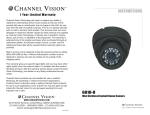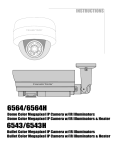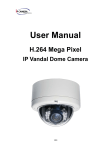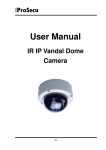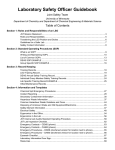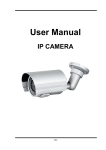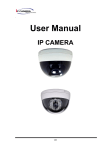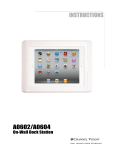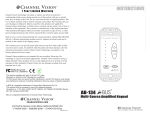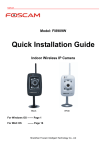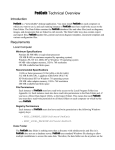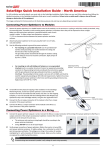Download - Channel Vision Technology
Transcript
Black Flush Mount IP Camera White Flush Mount IP Camera 6524-B, W H.264 IP Flush Mount Double Gang Camera Table Of Contents Model Info.........................................................................................................................................Page 3 Safety Warning.................................................................................................................................Page 4 Cable Pin-out....................................................................................................................................Page 5 Assigning an IP Address.................................................................................................................Page 6 Assigning an IP Address /cont.......................................................................................................Page 7, 8 9 Connecting To Your Camera...........................................................................................................Page 10 ActiveX Control................................................................................................................................Page 10 Configuring Internet Explorer.........................................................................................................Page 11 Live Viewing......................................................................................................................................Page 12, 13 Configuration....................................................................................................................................Page 14 System Configuration..................................................................................................................... Page 15 User Management............................................................................................................................ Page 16 System Update.................................................................................................................................Page 17 Network.............................................................................................................................................Page 18,19, 20, 21 Video Settings.................................................................................................................................. Page 22, 23, 24 Event List..........................................................................................................................................Page 25, 26 Schedule...........................................................................................................................................Page 27 Micro SD Card..................................................................................................................................Page 28 Micro SD Card /cont........................................................................................................................Page 29 Port Forwarding..............................................................................................................................Page 30, 31 Specifications.................................................................................................................................Page 32 Warranty..........................................................................................................................................Page 33 2 Model 6524 Thank you for purchasing Channel Vision's 6524 flush mount IP camera. Please take the time to read over these instructions to ensure proper installation and usage. The 6524 is an outdoor flush mount H.264 IP camera. Key features include: • Built-in web server, allows users to view high quality, real-time video with the Internet Explorer browser • Uses H.264, MJPEG and MPEG4 codecs • Live video can be recorded to a computer and played back remotely, as well as viewed from many mobile phones and other devices • Designed for large commercial projects using hundreds of cameras or a single family house requiring a camera at the front door 6524 Features: • Channel Vision’s 6524 outdoor flush mount camera offers superior image quality with a 1.3 megapixel CMOS sensor and has the ability to capture images up to 1200 x 800 pixels • With H.264 compression, less bandwidth and storage space are used, while delivering full resolution at max frame rate with faster speeds over the internet • The 6524 also features event triggered micro SD card recording (sd card not included) • Monitoring can be done anywhere an internet connection is available even from a 3G Smartphone or touch-screen tablet • PC board protected with silicone conformal coating that protects electronics from moisture, thermal shock, and vibration 3 Safety Warnings IMPORTANT SAFETY INSTRUCTIONS 1. Read these instructions. 2. Keep these instructions for future reference. 3. Heed all warnings. 4. Follow all instructions. 5. Do not use this device near water. 6. Clean only with a dry cloth. 7 Install in accordance with these instructions. 8. Do not install near any heat sources such as radiators, heat registers, stoves, or other apparatus that produce heat. 9. Do not defeat the safety purpose of the polarized-type plug. A polarized plug has two blades with one wider than the other. The wide blade or the third prong are provided for your safety. If the provided plug does not fit into your outlet, consult an electrician for replacement of the obsolete outlet. 10. Protect the power cord from being walked on or pinched particularly at plugs, convenience receptacles, and the point of exit from the apparatus. 11. Only use attachments/accessories specified by Channel Vision. 12. Unplug this apparatus during lightning storms or when unused for long periods of time. 13. Refer all servicing to qualified service personnel. Servicing is required when the apparatus has been damaged in any way, such as power supply cord or plug is damaged, liquid has been spilled or objects have fallen into the apparatus, the inside of the apparatus has been exposed to rain or moisture, does not operate normally, or has been dropped. 14. The lightning flash with an arrowhead symbol within an equilateral triangle is intended to alert the user to presence of uninsulated dangerous voltage within the product’s enclosure that may be of sufficient magnitude to constitute a risk of electric shock to persons. 15. The exclamation point within an equilateral triangle is intended to alert the user to the presence of important operating and maintenance accompanying the appliance. 16. Inside of apparatus shall not be exposed to dripping or splashing and objects filled with liquids. CAUTION: To reduce the risk of electric shock, do not remove the cover (or back). There are no user-serviceable parts inside, refer servicing to qualified service personnel. 4 CAUTION RISK OF ELECTRIC SHOCK DO NOT OPEN ! Cable Pin Out D C 12V Ethernet Connector (T568B Standard) WARNING: DO NOT CUT THE BREAKOUT CABLE. CUTTING THE CABLE WILL VOID THE WARRANTY ON THE DEVICE. How To Install Gasket Two gang box CAT5 extension (not included) Smoked plexiglass Power 2-Conductor power supply extension (not included) Network router Crimp-on splice connectors (not included) Power supply (included) 5 Assigning an IP Address 1. Connect the IP camera to the switch/router. 2. Power on the IP camera. 3. Use the software, “IP Installer” to assign the IP address to your 6524, you can find "IP Installer" in the supplied CD. 4. Execute IP Installer. This is located on your disk under the folder “IP Installer”. 5. Press “Search” 6. Click on the “Server name” that is found in IP Installer. 7. If Windows prompts you to unblock IP Installer, you must select “unblock”. There are 3 kinds of IP configuration: A. Fixed IP (Public IP or Virtual IP) B. DHCP (Dynamic IP) C. Dial-up (PPPoE) 6 "IP Installer" will search all IP Cameras connected to your LAN network.The user can click “Search Device” to search again. Assigning an IP Address, cont. 1. Click the start icon on your computer 2. Click the ‘Run’ icon on your computer. 3. Type in ‘cmd’ and press enter on your keyboard, or press ok. 4. Type in ‘ipconfig /all’ into the DOS prompt that appears. Press enter. 5. Write down your computer’s IP address. It is important that you do not use the same IP address for your IP Camera. In the example below, the computer’s IP address is 192.168.1.74. The IP address of the IP Camera must be different than the IP address in the computer. Each networkable device in your network has an IP address assigned. You need to be sure the IP you choose for your IP camera is not the same as any other device on your network. 7 Assigning an IP Address, cont. 6. Copy/write down the following information from the DOS prompt: A. Default Gateway (Example 192.168.1.1) B. DNS Server (if 2 servers, use the first one, for example 192.168.1.9) C. Subnet Mask (Example 255.255.255.0) 8 Assigning an IP Address, cont. 7. Enter the information you wrote down from step 6 on page 9 into the IP camera network page A. Default Gateway (Enter this number under “Gateway”) B. DNS Server (Enter this number under “DNS 1”) C. Subnet Mask (Enter this number under “Netmask”) 8. Giving the IP Camera a unique IP address. Assign and IP address to the IP Camera by using the first 3 sets of numbers of your default gateway. An IP address, has 4 sets of numbers, each followed by a period. (Xxx.xxx.xxx.xxx) Using 192.168.1.1 as an example of the default gateway, the IP Camera’s address will start with 192.168.1.xxx 9. Make sure you use a number different than that of your computer’s IP address. (Generally between 2-250) This number needs to be out of the range of DHCP. DHCP is assigned with your router, and can be checked by logging into the router. For example, if the IP address of the computer you are using is 192.168.1.74, the IP address 192.168.1.208 could be used for your IP Camera. You must choose a number that is different from your computer’s IP. If your IT technician has designated a static internal IP for your IP Camera, use that address. 10. To assign the port, choose a port between 5400-9000, and type it into “Port 1”. If a specific port has been designated for your security system, that can also be used, even if the number is not within the range of 5400-9000. First 3 numbers are same as computer Select “Static” Name Fourth number (different than computer) Subnet Mask (same as computer) Default Gateway (same as computer) DNS Server 1 (same as computer) DNS Server 2 (same as computer) Port (A port between 8000-8999 is recommended, but any network port can be used) To change numbers, select the appropriate area on IP installer with your mouse, and type in the info. *Disclaimer: This is an example based on a general network setup. All networks do not match these settings exactly, as all networks are different. 9 Connecting To Your Camera 1. Open Internet Explorer. Type the IP address of the IP camera into the browser link window. Also, make sure to type the port at the end of the link. For example, http://192.168.1.245:8021 has been used. 2. You will be prompted for a username and password. The default username is ‘admin’ The default password is ‘admin’ Installing The ActiveX Control 1.) The first time you connect to the camera via Internet Explorer, it will ask you to install the ActiveX control. Internet Explorer 6, 7, 8, or 9 must be used to run this ActiveX control. 10 Configuring Internet Explorer If the installation of the ActiveX control fails, for example the browser page says “done,” but you do not see your camera, please check the security settings for your IE browser. Follow the instructions below: Step 1 Step 2 Step 3 Step 4 Step 5 When the following dialogue box popups, click “Yes”. 11 Live Viewing Once you connect, you will see a screen with the video feed from your camera. Below the icons and their functionality is described. Snapshot Settings Controls the selection of the video stream that is being viewed Shows the number of users connected at any given time Reflects the physical size of the streaming video on the browser screen Format: Year/Month/Day/Hour/Minute/Second/Image Size/Frames Per Second 12 Live Viewing, cont. 1. This icon opens the settings menu 2. This icon takes a snapshot 3. This icon show system time, video resolution, and video refreshing rate 4. The bottom bar has an icon that allows you to select which stream you want to view. Stream 1 is usually the larger, better quality stream. Stream 2 is the smaller stream, generally used for mobile viewing 5. The bottom bar has an icon shows how many users are connected to the IP camera. 6. If you double click the video feed, it will make the video full screen. To change video back to normal mode, press ‘Escape’ on your keyboard, or double click anywhere in the video feed a second time. 7. If you right click on the video, you have access to several different functions. A. Snapshot: Takes a snapshot B. Record Start : Records video to your computer C. Full Screen: Maximizes the video to full screen D. Zoom Digital zoom 1. Select “Enable digital zoom” 2. Select the area of the screen you wish to zoom in on 3. Select the zoom level 1 3 13 2 Configuration 1 1. Select this icon to enter the settings menu 2. Select this icon to go back to your live video feed 14 2 System Configuration System Information: Use the number scheme below for a description of each item: 1. MAC (Media Access Control) Address: This is a unique identifier assigned to IP devices for communication with the network. Your IP camera is pre-set with a MAC address 2. Server name: Select to edit the camera name 3. LED Indicator: Select On/Off to toggle the blinking LED light in the camera 4. Language: Select a language to change the language of the ActiveX interface 5. Status Bar: Select On/Off to toggle the information bar (below the main video stream) 6. Time Stamp: Select Enabled/Disabled to turn the video timestamp on or off 7. Text: Select Enabled/Disabled to specify the name that can be displayed on the top left area of the screen 8. Server Time: This shows the current time on your IP camera 9. Date Format: Select to choose your desired date format 10. Time Zone: This shows your current time zone 11. NTP: The Network Time Protocol is a protocol for synchronizing the clocks of computer systems 12. NTP Server: If you have a NTP server, input it here 13. Update: If using an NTP server, select this drop down menu to choose the update interval 14. Time Shift: Time shift is used to compensate for the time it takes to server to process the sync request for your time. This is usually not needed. 15. Synchronize with PC’s time: Select this to match your computer’s clock to your IP camera 16. Apply: Select this button to save your changes 1 5 2 3 4 6 7 8 9 10 11 12 13 14 15 15 16 User Management User managment: This IP camera supports 3 different types of users. 1. Administrator 2. General 3. Anonymous Click “Yes” to allow anonymous user access Click “Add/Set” to add a user. Click “Edit” to modify a user. When you click edit, the following window will pop up: (Shown below.) Add the username and password, and click “OK” to save your new user. 16 System Update System Update: This menu is used to perform the following functions: 1. Firmware Update: Channel Vision will update the firmware from time to time. By registering your IP camera, you have access to all firmware improvements and extended warranty options. See our warranty web page for more information: http://www.channelvision.com/index.php/product-warranty/ To load new firmware, press “Browse” and select the firmware.bin file. 2. Restart System: Select to restart system. You can reset the IP camera to factory default settings if desired If you backup your settings, you can load your backup file where it says “New Setting File”. 3. Settings backup: You can backup your settings by right clicking your mouse on “Setting Download” and selecting “Save Target As”. You may also load previously saved settings files this way. When loading previously saved files, click “Browse” and then “Upgrade” 17 Network Network Setup/IP Setting: Setting up this menu will allow Internal and External Camera Viewing over the internet. Once setup, you will be able to view this camera from anywhere in the world. This IP camera supports DHCP and Static settings. If you are new to installing an IP camera, use #2 (Static IP). Internal Network Connections: This IP address will be the only way to view the camera while on an internal network. See page 19 for an example. 1. DHCP: If you use this setting, your IP information will be pulled automatically from your router. This not recommended if you are going to view this camera outside of the building that it resides in. 2. Static IP: This is an IP that you manually set. This IP must not be the same as any other device within your network. You must also set default gateway, DNS server, subnet mask, and DNS server. Please refer to page 6 & 7 for instructions on how to obtain these numbers. 3. Port Assignment: You can assign different ports for your camera. (Explained below.) A. Web Page Port: (This is the port that 99% of installations will use) A web page port is used to transmit data out of your network. For example, if the external IP address is http://67.88.12.50, and the port was 5400, the final address would be http://67.88.12.50:5400 For information on network ports, please refer to the link below: http://en.wikipedia.org/wiki/Network_ports B. RTSP Transmitting Port: For information on RTSP, please refer to the link below.: http://en.wikipedia.org/wiki/Real_Time_Streaming_Protocol C. RTP start and end port: In RTSP mode, you may use TCP and UDP for connecting TCP connection uses RTSP port (554) UDP connection uses RTP start & end port. 4. UPnP: This IP camera supports UPnP. If this service is enabled on your computer, the camera will be automatically detected and a new icon will be added to “My Network Places”. For information on UPnP, please refer to the link below: http://en.wikipedia.org/wiki/UPNP Below are instructions on how to activate UPnP on your computer: A. Open the control panel from the start menu B. Select “Add/Remove programs” C. Select “Add/Remove Windows components” D. Open “Networking Services” section E. Click “Details” and select UPnP to setup the service F. Once activated, the IP camera icon will appear in “My Network Places” G. You can now double click that icon to access the camera with your IE browser 18 Network, cont. Below is an example of the network settings menu. This is where you key in all of your IP information from your network. These settings must be entered correctly in order for the IP camera to be viewable over the network. With this setting, the way to view the IP camera in your network is this: http://192.168.1.207:8005 (Use any browser) 5. PPPoE: Check the PPPoE “Enabled” button to activate this function. 19 You can key in a username and password for the connection if you are using ADSL. Send mail after dialed: When connected to the internet, this IP camera will send an email to the specified email account. To configure the IP camera email settings, please refer to the “Mail and FTP Settings” Network, cont. 6. DDNS: This IP camera supports DDNS (Dynamic DNS) service. Select “Enabled” to enable the DDNS service. To view the cameras over the internet while using a dynamic (rotating) IP address, there are many services available online. Channel Vision offers a DDNS service. To find out more information, go to the www.channelvision.com and navigate to the 6524 product page. 1. Enable the service 2. Key in the DynDNS server name, username, and password 3. Set up the IP update refresh rate 4. Click “Apply” 5. If it updates too often, the IP will be blocked by DynDNS. Channel Vision recommends you set it to update once per day (1,440 minutes). 20 Network, cont. 7. Mail & FTP: Enter your Mail and FTP information into the menu below: Mail: Mail is a way the IP camera can send you an email when certain actions occur, for example motion, a contact closure on the sensor, etc. FTP: FTP is for uploading recorded files to a designated FTP site Please note: Due to spam settings, you may not be able to use the following free services: Live.com Hotmail.com Yahoo.com Gmail.com Mail.com Apple.com MSN.com 21 Video Settings Image Setting: You can adjust the following items on this camera: 1. Brightness: This adjusts the brightness level of the camera 2. Contrast: This adjusts the difference in color and light between parts of an image 3. Hue: This adjusts the hue level of the image 4. Saturation: This adjusts the color saturation in the image 3. Sharpness: This adjusts how sharp the image appears 4. AGC: This adjusts the automatic gain control 6. Shutter Time: This regulates the amount of light allowed into the camera 7. Sense-Up: This adjusts shutter speeds 8. D-WDR: This is digital wide dynamic range 9. Video Orientation: This will allow you to flip or mirror the video stream 10.Video Noise: This allows adjustment of the video noise 1 2 3 4 5 6 7 8 9 10 11 You can reset your IP camera’s image settings to default by pressing the “default” button. 22 Video Settings, cont. Stream 1&2 Setting: Click the drop down list to select Input Type (NTSC or PAL) 1. Resolution: There are 5 resolutions you can choose from: 1280x800@30fps 1280x720@30fps 640x480@30fps 320x240@30fps 176x144@30fps 2. Quality: There are 5 levels you can adjust to: Best, High, Standard, Medium, & Low. If you use the highest settings, the network streaming speed will be slower. Also, if you record any files, the higher the quality, the larger the file will be. 3. Video Frame Rate: The video refresh rate per second. Setting max is 30 FPS (NTSC) and 25 FPS (Pal) at 1280x800 and best quality 4. Video Format: This describes the codec used for compression. H.264 is newer and higher quality, and MJPEG (JPEG) is an older, but may stream faster. 5. RTSP Path: RTSP output name. Rtsp path would be as follows: rtsp://camera/v2 23 Video Settings, cont. Stream 1&2 (Advanced Mode): 1. Resolution: There are 5 resolutions you can choose from: 1280x800@30fps 1280x720@30fps 640x480@30fps 320x240@30fps 176x144@30fps 2. Bitrate Control mode: There are 2 choices: CBR (Constant Bit Rate) and VBR (Variable Bit Rate) A. CBR: 32Kbps-8Mbps (The higher the CBR, the better your video quality will be) B. VBR: 1 (Low) -10 (High) Compression rate. The higher the compression rate the higher the picture quality, and vice versa. The balance between VBR and network bandwidth will affect your picture quality. When using VBR, it is less likely that your streaming video will break up or lag. 3. Video Frame Rate: The video refreshing rate per second NTSC: Max 30 frames per second PAL: Max 25 Frames per second (stream 1) NTSC: Max 15 frames per second PAL: Max 10 Frames per second (stream 2) 4. GOP Size: This means “Group of Pictures.” The higher the GOP is, the better the quality of the images. 5. Video Format: This describes the codec use for compression. H.264 is newer and higher quality, and MJPEG (JPEG) is older, but will stream faster. 6. RTSP Path: RTSP output connecting route For example: rtsp://camera/v2 24 Event List 1. Event Setting: The purpose of this menu is to configure what the camera will do when an “event” is generated. 2. Motion Detection The 6524 allows 3 areas of motion detection. (Area Setting) When motion is triggered, the camera can send the video, in the form of events to a specific mail address, transmit the live video to a remote FTP server and save events in the form of video to local micro SD card. To set up the motion area, click “Area Setting”. Use the mouse to click and drag a box of the area you want to select. The same method is used for area 2 and area 3. 3. Record File Setting: The 6524 allows 3 different types of recording files: A. AVI File (With time stamp) This is the largest file size option to choose, and the video will be the highest quality available. B. JPEG (MJPEG) File (With time stamp) This is a smaller file size to choose, and will be lower quality than the AVI format. C. JPEG (MJPEG) Single file with interval setting. 25 Event List, cont. 4. Record Time Setting: Pre Alarm and Post Alarm setups for record start and end time when motion is detected, or to trigger a relay. Note: Pre/Post Alarm record time are based on record time setting and 6524’s built-in memory. The ability to store data is limited, so if the video quality is set very high, this will cause a drop in the recorded FPS. This will also decrease pre or post recording time. 5. Network IP Check: This option does two things. One, it checks your internet connection (Interval) to make sure your network connection has not been lost. Two, if your connection is lost, you can set this to automatically record to the SD card until it is full. “IP Check” enables or disables this feature. “IP Address” is what the camera will use to check if the internet is still working. “Interval” is how often the camera will test your internet connection. “IP Check” (lower option) has a box to check. When you check this box, you will record to your micro SD card upon network failure. 26 Schedule 1. Schedule: Complete schedule setup to tell the 6524 when to record data. If schedule setup is not activated, the camera will not record to its SD card. 2. Snapshot: After enabling the snapshot function, user can select the storage Click “Enabled” to enable snapshot. Select the E-mail, FTP, or Save to micro SD card option to enable. Click the desired areas (boxes) to designate recording time. Green=record 27 Micro SD Card Below is a picture showing the location of the micro SD card in the 6524. Using the micro SD card option could affect the frame rate of the video. Make sure the micro SD card is pushed into the slot completely. The capacity of the SD card is shown in the SD card menu. Below is a list of the video files recorded. The video format recorded to the SD card is AVI. Double click the video to open Windows Media Player and play the selected file. To delete the video, check it with the mouse, then click the Del button. When the SD card is full, it will automatically delete the oldest video files. 28 Micro SD Card, cont. Below is a list of Micro SD cards that Channel Vision has tested and confirmed full functionality with the 6524 IP Camera: 29 Port Forwarding In order to view the IP camera from outside of your home or business network, port forwarding configuration will be required in your router. Below are several points of reference regarding port forwarding: 1. http://en.wikipedia.org/wiki/Port_forward The wikipedia page explains what port forwarding is, how it is used, and what its applications are. *This website is not affiliated with Channel Vision 2. http://screenshots.portforward.com/ This website contains picture by picture walkthroughs on how to port forward most routers on the market. *This website is not affiliated with Channel Vision Port Forwarding LG Routers In the example below, there is a 6524 running on port 8002 on the LAN. 1. Add the IP information, including the desired port into the port forwarding tab of “advanced” in the router. 2. Check “Enable Port Forwarding”. 3. Click “Add”. 4. Click “Select”. 5. Select “Apply” to enable your new port forwarding rule 30 Port Forwarding, cont. Over the course of setting up hundreds of DVRs and IP Cameras, Channel Vision has found some routers to be problematic. 1. Some modem/router combinations do not work the customary way with this IP Camera. You cannot set up the IP Camera on “LAN” and must select “DHCP” in IP Installer. Once you do this, there is a good chance that the IP Camera will show up in the modem/router, allowing you to port forward the IP Camera. If you give the IP Camera a LAN address, the modem/router will not detect it, and you cannot port forward it. In some cases, if you assign the IP camera a static IP in the modem/router, it will be detected. Generally, this is not the case. 2. Port forwarding does not work in all routers. Sometimes, a router doesn’t have the ability to do port forwarding. This is very rare. 3. Port forwarding may not work in a router because it is defective, though this should not be the first assumption that is made. 4. The router is set up for port forwarding, and the IP Camera works inside of the network, however, the IP Camera does not work externally. (From a different network) There are many reasons this could happen, for example: A. The IP Camera network page is not set up properly. For example, the IP Camera may be missing the DNS server, or the subnet mask is wrong. It will still connect internally usually, but not externally. B. A network with 2 routers installed. An IP camera cannot be port forwarded properly if two routers exist in the same network. The only exception to this is if one router is completely disabled and being used only as a wireless access point. 31 6524 Specifications CPU: DDR2: Flash: Image Sensor: Sensitivity: DC Iris: Lens Type: Power Over Ethernet: Power Consumption: Ethernet: Network Protocol: ARM 9; 32 Bit RISC 256MB 16MB 1/4” CMOS (1.3 Megapixel) 1.0 Lux at 30fps Yes Fixed 4.3mm Supported, Designed For 802.3af Standard, 47V Recommended 12vDC 480mA 10/100 Base T HTTP, HTTPS, SNMP, QoS/DSCP, Acess list, IEEE, 802.1X, RTSP, TCP/IP, UDP, SMTP, FTP, PPPoE, DHCP, DDNS, NTP, UpNP, 3GPP, Samba Video Resolution: Triple Streaming: Image Snapshot: Full Screen Monitor: Privacy Mask: Compression: Bit-rate Adjustment: Motion Detection: Triggered Actions: Security: 1280x800@30fps, 1280x720@30fps, 640x480@30fps, 320x240@30fps, 176x144@30fps Yes Yes Yes Yes H.264, JPEG, MPEG-4 CBR, VBR 3 Areas Mail, FTP, Save to Micro SD card; Samba Password protection, IP address filtering, HTTPS encrypted data transmission 802.1X port based authentication for network protection SD Card Management Recording Trigger: Video Format: Video Playback: Specific File Deletion: Motion Detection, IP check, Network Failure, (wire only) Schedule AVI, JPEG Yes Yes System Requirements OS: Windows 2000, XP, Vista, 7 Browser: Microsoft IE 6.0 or above Suggested Hardware: Intel Dual Core 1.66G,RAM: 1024MB, Graphic card: 128MB Minimum Hardware: Intel-C 2.8G, RAM: 512MB, Graphic card: 64MB *Specifications subject to change without notice. 32 1 Channel Vision Technology will repair or replace any defect in material or workmanship which occurs during normal use of this product with new or rebuilt parts, free of charge in the USA, for one year from the date of original purchase. This is a no hassle warranty with no mail in warranty card needed. This warranty does not cover damages in shipment, failures caused by other products not supplied by Channel Vision Technology, or failures due to accident, misuse, abuse, or alteration of the equipment. This warranty is extended only to the original purchaser when purchased through an authorized reseller. A purchase receipt, invoice, or other proof of original purchase date will be required before warranty repairs are provided. Mail in service can be obtained during the warranty period by calling (800) 8400288 toll free. A Return Authorization number must be obtained in advance and can be marked on the outside of the shipping carton. This warranty gives you specific legal rights and you may have other rights (which vary from state to state). If a problem with this product develops during or after the warranty period, please contact Channel Vision Technology, your dealer or any factory-authorized service center. Channel Vision products are not intended for use in medical, lifesaving, life sustaining or critical environment applications. Channel Vision customers using or selling Channel Vision products for use in such applications do so at their own risk and agree to fully indemnify Channel Vision for any damages resulting from such improper use or sale. www.channelvision.com 234 Fischer Avenue, Costa Mesa, California 92626 USA (714)424-6500 (800)840-0288 (714)424-6510 fax email: [email protected] 500-314 rev D


































